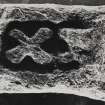Pricing Change
New pricing for orders of material from this site will come into place shortly. Charges for supply of digital images, digitisation on demand, prints and licensing will be altered.
Inchmarnock, Midpark
Cross (Early Medieval)
Site Name Inchmarnock, Midpark
Classification Cross (Early Medieval)
Alternative Name(s) Carved Stone 9
Canmore ID 301939
Site Number NS05NW 2.09
NGR NS 0234 5965
Datum OSGB36 - NGR
Permalink http://canmore.org.uk/site/301939
- Council Argyll And Bute
- Parish North Bute
- Former Region Strathclyde
- Former District Argyll And Bute
- Former County Buteshire
Artefact Recovery (1890)
Reference (1893)
Artefact Recovery (1974)
Photographic Record (1974 - 1975)
Reference (1984)
Reference (1990)
Measured Survey (1992 - 1994)
Photographic Record (1993)
Reference (1996)
Reference (2001)
'Two fragments of a massive cruciform stone of greenish schist. The lower and smaller piece was found in the stackyard wall NW of the church about 1890 and was donated to Bute Museum in 1913. In 1987 it was reunited with the upper part, which was found in the same wall in 1974. A section about half the width of the shaft is broken away at the oblique break between the two fragments, but the surviving surfaces of the break match closely, and the correspondence of the foliations on the edge confirms beyond all doubt that the stone is complete except for some damage at the top and the loss of one side-arm (i). It measures 1.54m in length, the shaft is 0.32m in maximum width, and the maximum thickness is about 80mm. The surviving side-arm projects obliquely upwards and is about 0.15m long and 0.35m high. The stone is carved on both faces, except for a slightly expanded butt about 0.22m high. One face (a) is filled by an irregular Latin cross, defined by a groove up to 50mm wide except at the ends of the arms which continue into the broad margin. Just below the top of the lower fragment the shaft swells out to interrupt the groove, possibly indicating a lower transom or else defining a pedestal, but the detail is obscured by the break and associated flaking. On face (b) the lower fragment bears two saltires in false relief within a rectangular panel, separated by a transverse bar from a single saltire. Above the break two deep grooves define a central vertical bar which splits at the cross-head to run into the margins of the side-arms. The crude interlace filling the cross-head, executed with deep grooves of V-section which retain coarse punch-marks, has affinities with the 'stopped plait' found in carvings of Anglo-Scandinavian character in west Cumbria and Galloway, and at Govan (j). It may incorporate two birds shown beak-to-beak, but the crudity of the carving and extensive surface-flaking make interpretation difficult. The top arm, whose upper part is lost, retains a vertical central bar which may have been the shaft of a small Latin cross.
(Hewison 1893, 1, 223 (lower part only); Marshall 1990, 5-7; Speirs 1996, 60; Cross 1984, M2 (lower part) and M14).
I Fisher 2001
Reference (2008)






























